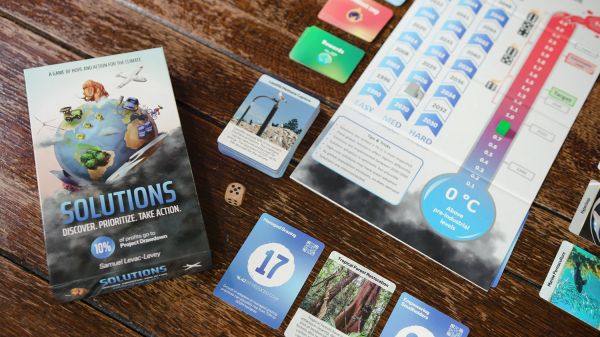Games as a Tool for Education and Action

This is a guest blog by Sam Levac-Levey, Founder and Game Designer of Solutions, the Game. Sam's insight into active learning with an eye toward long term sustainability are inspiring. Enjoy!
Best wishes, Donna Goodman
We believe that games can foster enthusiasm, creativity, and long-term learning in students. We developed a board game about solving climate change and tested it on over 500 students, leading to fun and meaningful discussions. The game acts as a starting point for real-world class projects that give students a sense of agency and hope about this difficult topic.
How can you take a complex and depressing global issue like climate change and inspire students, teachers, and the entire faculty at a school to take meaningful action?
People have an innate desire to play, because playing is one of the first ways that we learn when we're born. We connect deeply with things when we play. With the subject matter, with our own thoughts, with the people we're playing with.
For example, If I asked the average student to think about the global implications of destroying peatlands, they might think it's boring homework. But if you give them a goal, they become motivated to do it. Even if it's something they've never thought about before, they start stretching their minds based on their previous experiences to really engage with it. They're really connecting with their own thoughts.
We set out to develop a game that would make learning about climate solutions fun and engaging. This game was designed explicitly to designed with three goals in mind:

- Expose students to almost 100 unique and often surprising solutions to our climate crisis.
- Get students to think deeply and critically about the various solutions that they play.
- Motivate students to turn what they’ve learned into meaningful projects
Why focus on solutions rather than the science behind climate change? We’re all inundated with negative news about how we’re destroying our environment. The polar bears are dying, the ice sheets are melting - this is all critically important, but without a sense of hope and agency, it can cause students and adults alike to shut down and succumb to climate anxiety.
How many of your students could name 100 climate solutions? Or even 10? The list starts very easily: solar panels, wind turbines, electric cars - but quickly gets much harder. The problem is that the world has gravitated towards solutions in transportation and energy which are incredibly important, but only a part of the story. This is why we decided to draw source material from the game from groundbreaking research of Project Drawdown.
The Drawdown team took over 200 experts and analyzed 100 climate solutions, ranking them based on their potential for global impact. The book itself is tremendously inspiring - I personally read through it three times, flipping through the pages and thinking ‘where can I fit into this solution?’ ‘How could I help out with this one?’ But I believe the best way to get inspired with these solutions is to play with them.
After testing the game on elementary, middle school, high school, bachelors, masters, and PhD students, we’ve noticed that the discussions that different age groups have while playing Solutions vary in complexity, but the value in sparking discussions and creativity remains the same.

However, what we’re perhaps the most excited about is the potential for the game to inspire students to gain a sense of agency that they can do something meaningful to tackle this global problem, and take real-world action.
This is something we’ve already started to see during our playtesting! We sent the game to an elementary school in Palm Beach, Florida. Two grade 6 classes tried the game. While playing, they flipped over the ‘Reduced Food Waste’ solution - one of the most surprisingly impactful solutions in the game. After playing, both classes decided independently to do class projects for reducing food waste.
After playing, both classes decided independently to do class projects for reducing food waste. As their teacher, Cassie, explains in this video, the students started by measuring their food waste every day. They managed to reduce their food waste by 3kg/day in a short period of time, and are looking to do more. In fact, the game inspired not only the students, but also the faculty to bring back a garden and start composting.
While Cassie’s classroom is a picture-perfect example for how the Solutions game can help inspire climate projects in the classroom, it’s far from the only way. Different project types can fit the needs of different students and classrooms. Some ideas are:

- Students can turn any solution into a presentation. For example, the research behind each solution is global research. But how does the solution fit into your school’s local context?
- The solutions in the game can be a great source of inspiration for science fair projects.
Of course, we’re partial to real-world projects around the school or at home - as demonstrated by Cassie’s classes - because these are the types of projects that really give students agency and make them feel like they’re having real impact.
What types of projects would be a good fit for your classroom? Comment on this post or email me at sam@solutionsthegame.com to let me know!
If you’re interested in using the Solutions board game (link is external) as a teaching tool in your classroom, it’s live now on Kickstarter at the link here.

